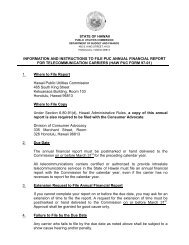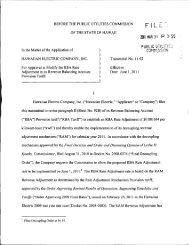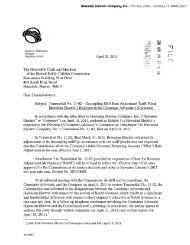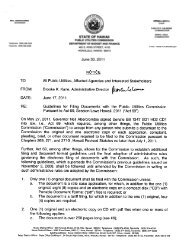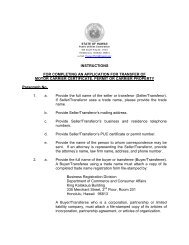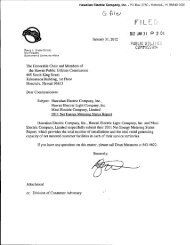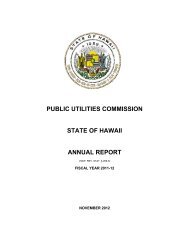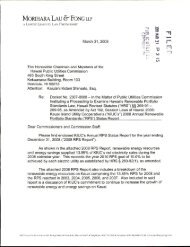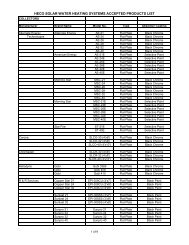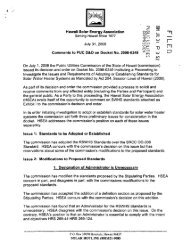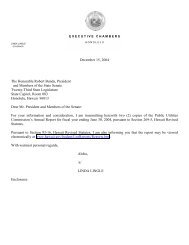PUC Annual ReportâFiscal Year 2004-05 - Public Utilities Commission
PUC Annual ReportâFiscal Year 2004-05 - Public Utilities Commission
PUC Annual ReportâFiscal Year 2004-05 - Public Utilities Commission
You also want an ePaper? Increase the reach of your titles
YUMPU automatically turns print PDFs into web optimized ePapers that Google loves.
<strong>Public</strong> <strong>Utilities</strong> <strong>Commission</strong> <strong>Annual</strong> Report <strong>2004</strong>-<strong>05</strong>State of Hawaii Page 89C. RENEWABLE PORTFOLIO STANDARDS.In 2001, the Hawaii State Legislature (“Legislature”) passed Act 272, SLH 2001(“Act 272”), which is now codified in HRS Sections 269-91 through 269-94. Act 272 was adoptedfor the purpose of lessening Hawaii’s dependence on imported oil by, among other things,establishing goals for electric utility companies in implementing renewable portfolio standards byincluding a minimum percentage of renewable energy resources within an overall resourceportfolio.Act 272 specifically stated that “[e]ach electric utility company that sells electricity forconsumption in the State shall establish a renewable portfolio standard goal of:(1) Seven per cent of its net electricity sales by December 31, 2003;(2) Eight per cent of its net electricity sales by December 31, 20<strong>05</strong>; and(3) Nine per cent of its net electricity sales by December 31, 2010.”Act 272 also allowed an electric utility company and its electric utility affiliates toaggregate their renewable portfolios in order to achieve the renewable portfolio standard. Forexample, HECO and its affiliates, HELCO and MECO, may add together their renewable energynumbers to meet the requisite goal.In <strong>2004</strong>, the Legislature passed Act 95, SLH <strong>2004</strong> (“Act 95”), which amended HRSSections 269-27.2, 269-91, 269-92, and added HRS Section 269-95. Act 95 was adopted for thepurpose of decreasing Hawaii’s need to import large amounts of oil, and increase importsubstitution, economic efficiency, and productivity, by increasing the use and development ofHawaii’s renewable energy resources through a partnership between the State and the privatesector.Act 95 increased the percentage of net electricity sales that an electric utility mustachieve in 2010 from nine (9) to ten (10) per cent and established new milestones for 2015 and2020 of fifteen (15) and twenty (20) per cent, respectively. The <strong>Commission</strong> is required todetermine if an electric utility company is unable to meet the renewable portfolio standards in acost-effective manner, or as a result of circumstances beyond its control which could not havebeen reasonably anticipated or amelioratedAct 95 required the <strong>Commission</strong> to: (1) Develop and implement a utility ratemakingstructure by December 31, 2006 to provide incentives that will encourage electric utilitycompanies to use cost-effective renewable energy resources to meet renewable portfoliostandards; (2) Determine the proposed ratemaking structure’s impact on utility companies’ profitmargins; (3) Contract with the Hawaii Natural Energy Institute of the University of Hawaii toconduct independent studies on the capability of Hawaii’s electric utility companies to achieverenewable portfolio standards in a cost-effective manner and on projected standards for five (5)and ten (10) years beyond the current standards; (4) Revise the standards based on the bestinformation available at the time if the studies conflict with the established standards; and(5) Report its findings to the 2009 Legislature and every five (5) years thereafter.The definition of “Renewable energy” was amended by Act 95. “Renewable energy”means electrical energy produced by wind, solar energy, hydropower, landfill gas, waste toenergy, geothermal resources, ocean thermal energy conversion, wave energy, biomassincluding municipal solid waste, biofuels, or fuels derived from organic sources, hydrogen fuelsderived from renewable energy, or fuel cells where the fuel is derived from renewable sources.Where biofuels, hydrogen, or fuel cell fuels are produced by a combination of renewable andnonrenewable means, the proportion attributable to the renewable means shall be credited asrenewable energy. Where fossil and renewable fuels are co-fired in the same generating unit, theunit shall be considered to produce renewable electricity in direct proportion to the percentage of



